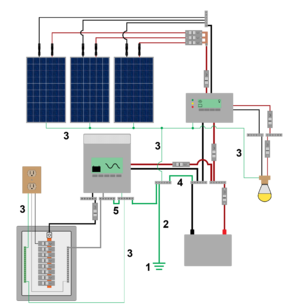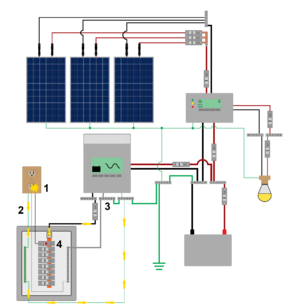Difference between revisions of "Grounding system"
| Line 47: | Line 47: | ||
#The equipment grounding conductor has a connection - due to the system ground - to the grounded conductor. The current follows it because it is a low resistance path to the grounded conductor, which completes the circuit. | #The equipment grounding conductor has a connection - due to the system ground - to the grounded conductor. The current follows it because it is a low resistance path to the grounded conductor, which completes the circuit. | ||
#The current reaches the grounded conductor and this effectively creates a [[Electricity and energy#Circuits: making use of electricity|short-circuit]] which causes the inverter to supply large a amount of current to the newly created low-resistasnce circuit. | #The current reaches the grounded conductor and this effectively creates a [[Electricity and energy#Circuits: making use of electricity|short-circuit]] which causes the inverter to supply large a amount of current to the newly created low-resistasnce circuit. | ||
| − | #This high current flow will be identified by the inverter electronics, residual current device (RCD) or an overcurrent protection device as a fault, which will cause the one of them to trip and [[Electricity and energy#Circuits: making use of electricity|open]] (disconnect) the circuit. A RCD or inverter electronics will react quicker than an OCPD. | + | #This high current flow will be identified by the inverter electronics, residual current device (RCD) or an overcurrent protection device (OCPD) as a fault, which will cause the one of them to trip and [[Electricity and energy#Circuits: making use of electricity|open]] (disconnect) the circuit. A RCD or inverter electronics will react quicker than an OCPD. |
These devices only temporarily remove the hazard, thus after a ground fault occurs its is necessary to carefully [[Troubleshooting|troubleshoot]] the system to locate the fault and fix it. | These devices only temporarily remove the hazard, thus after a ground fault occurs its is necessary to carefully [[Troubleshooting|troubleshoot]] the system to locate the fault and fix it. | ||
Revision as of 14:06, 1 December 2020
A grounding system creates a low-resistance connection between system equipment and/or a system conductor - called a neutral or grounded conductor - to the earth by using a grounding electrode. A grounding system is not necessary for an electrical system to function, the electrical distribution systems in some countries lack any type of grounding and others have complex grounding systems with additional measurement devices to protect users. In offgrid installations, it is common for small-scale DC-only PV systems operating at below 50 V to lack a grounding system as it would increase the cost substantially without providing significant benefit. As system size, voltage, and cost increase the benefits of a grounding system grow. The electrical code for every country will contain information about the requirements and appropriate equipment for that location.[1]
Additionally, it is necessary to consult the manual for any charge controller or inverter before deciding upon a grounding scheme as they may have different requirements for grounding. There are a few cases that are worth noting here:
- There are some small inverters - modified sine wave and square wave - that will be destroyed if they are connected in a system that has both an AC and a DC system ground as they do not properly isolate their DC input from the AC output.
- There are some charge controllers that are intended for specific applications, like remote telecommunications installations, that are positively grounded.
TN-S grounding system
Most off-grid systems are designed for use with a TN-S grounding scheme, although they can be used in a variety of configurations. This scheme has a grounded conductor (neutral) and a seperate equipment ground that is run with each circuit to bond together non-current carrying metal parts of the system (enclosures or major system components).[2] A TN-S grounding scheme has has two major functions that work together:
- System grounding - System grounding is created by connecing one current-carrying conductor of an electrical system to ground. A proper system ground provides a means to dissipate excess static electricity created by friction or lightning. This helps to create a stable system voltage and protect system equipment from damage.
- Equipment grounding - Equipment grounding is created by connecting all non-current carrying metallic components of a system to ground. Thise creates a path for any current created by a fault - due to failure of insulation or a loose connection - to return through the equipment grounding or the earth to the grounded conductor.
A proper grounding system requires various different components that are connected together in order for the system to work effectively and safely.
| Component | |
|---|---|
| (1) Grounding electrode | The connection point between the earth and the electrical system. There are many different types of electrodes - copper rods, steel rods, a copper plate, the metallic pipes of a building, or a proper connection to the rebar used in the foundation of a building. |
| (2) Grounding electrode conductor (GEC) | The connection that runs from the grounding electrode to the location of the rest of the electrical equipment - typically a wire that runs from the grounding electrode to a grounding busbar in the main distribution panel. |
| (3) Equipment grounding conductor (EGC) | The connection that runs from the grounding busbar in the main service panel to all of the non-current carrying metallic components of a system (conduit, inverter housing, charge controller housing, enclosures, etc.). |
| (4) DC system ground | The connection between a DC current carrying conductor in an electrical system and the grounding electrode conductor - commonly made through a ground fault protection device. |
| (5) AC system ground | The connection between an AC current carrying conductor in an electrical system and the grounding electrode conductor - typically made immediately after the inverter output at a busbar used for the inverter output circuit or in the main distribution panel. The connection is made from the main grounding busbar to the busbar of the grounded conductor. There are some inverters that come with a pre-established internal system ground, for example any that come with an integrated ground fault protection device (GFPD). A second system ground should not be created. |
Ground faults
A ground fault occurs when a current carrying conductor of an electrical system has an insulation failure or comes loose from a connection and makes contact with somethat that has a connection to ground. Ground faults can be very dangerous because they can lead to electrocutions and fires, therefore it is important to identify them as quickly as possible and disable them. When there is a ground fault, current escapes the wires of a circuit and seeks other paths to be able to complete the circuit. A person who grabs something that has been energized by a fault to ground can become a path to complete the circuit and be electrocuted. In a properly grounded system the most common ground fault scenario is a ground fault between an ungrounded current-carrying conductor (black wire) and a grounded piece of equipment. A ground fault can occur with a grounded conductor but it will not typically be apparent until there is a second ground fault involving the ungrounded conductor (black wire).
System grounding and equipment grounding work with overcurrent protection devices, ground fault protection devices, residual current devices and inverter electronics to identify faults and disable them as quickly as possible by opening (disconnecting) the circuit. This system functions because a fault to an equipment grounding conductor will create a short circuit if there is low enough resistance, which will activate these devices and cause them to open (disconnect) the circuit.
A AC ground fault involving an ungrounded conductor typically occurs as follows:
- A ground fault occurs between a grounded piece of equipment and an ungrounded conductor (wire).
- The equipment grounding conductor has a connection - due to the system ground - to the grounded conductor. The current follows it because it is a low resistance path to the grounded conductor, which completes the circuit.
- The current reaches the grounded conductor and this effectively creates a short-circuit which causes the inverter to supply large a amount of current to the newly created low-resistasnce circuit.
- This high current flow will be identified by the inverter electronics, residual current device (RCD) or an overcurrent protection device (OCPD) as a fault, which will cause the one of them to trip and open (disconnect) the circuit. A RCD or inverter electronics will react quicker than an OCPD.
These devices only temporarily remove the hazard, thus after a ground fault occurs its is necessary to carefully troubleshoot the system to locate the fault and fix it.
Notes/references
- ↑ Cahiers Techniques 173: Earthing Systems Worldwide and Evolutions https://www.mikeholt.com/documents/mojofiles/electricalearthingworldwide.pdf
- ↑ SMA Grounding in Off-grid Systems: Design of TN and TT Off-Grid https://files.sma.de/downloads/SI-OffGrid-Grounding-TI-en-11.pdf

